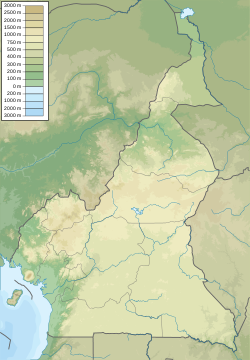ဘရွန်ဘိဘိုကန်
| ဘရွန်ဘိဘိုကန် | |
|---|---|
 Satellite photo from NASA. Barombi Mbo is the largest circular lake, just above center. | |
| ကိုဩဒိနိတ် | 4°40′N 9°24′E / 4.667°N 9.400°Eကိုဩဒိနိတ်: 4°40′N 9°24′E / 4.667°N 9.400°E |
| အမျိုးအစား | Volcanic crater lake |
| ပင်မ ရေထွက်စီးကြောင်း | Mungo River |
| ရေချိုင့်ဝှမ်းရှိရာ နိုင်ငံများ | Cameroon |
| အကျယ်ဆုံး အလျား | ၂.၁၅ km (၁.၃၄ mi) (diameter)[၁] |
| မျက်နှာပြင် ဧရိယာ | ၅ km2 (၁.၉ sq mi)[၂] or ၇ km2 (၂.၇ sq mi)[၃][၄] |
| ပျမ်းမျှအနက် | ၆၉ m (၂၂၆ ft)[၂] |
| အနက်ဆုံး အနက်အရှိုင်း | ၁၁၁ m (၃၆၄ ft)[၂] |
| ပင်လယ်ရေ မျက်နှာပြင်အမြင့် | ၃၀၀ m (၉၈၀ ft)[၂] |
| တရားဝင်အမည် | Barombi Mbo Crater Lake |
| ရွေးချယ်ခြင်း | 8 October 2006 |
| ရည်ညွှန်းနံပါတ် | 1643[၅] |
ဘရွန်ဘိဘိုကန် သည် ကင်မရွန်းနိုင်ငံ၊ အနောက်တောင်ပိုင်းဒေသ၊ ကမ်ဘမြို့အနီးတွင် တည်ရှိသည့် ကန်တစ်ခု ဖြစ်သည်။ ဤကန်သည် ကင်မရွန်းမီးတောင်လမ်းကြောင်းပေါ်ရှိ ကန်တစ်ခုဖြစ်သည်။ ထိုဒေသတွင် အကြီးဆုံး မီးတောင်မှဖြစ်ပေါ်လာသည့်ကန် ဖြစ်သည်။[၆] ဤကန်သည် အာဖရိကရှိ ရေဒီယိုကာဗွန် သက်တမ်းအကြာဆုံးကန်တစ်ခု ဖြစ်သည်။ ကိုလိုနီခေတ်ကာလများက ဤကန်ကို "ဆင်ကန်" ဟု သိကြသည်။ သို့သော်လည်း ထိုဒေသတွင် နေထိုင်ကြသည့် ဆင်များသည် တရားမဝင်ရောင်းဝယ်မှုများကြောင့် မျိုးတုန်းခဲ့ရသည်။[၇]
ရုပ်ပုံများ[ပြင်ဆင်ရန်]
-
Lake Barombi, Crater Lake
-
Full extent, Lake Barombi
-
Side view of Lake Barombi, Kumba
ကိုးကား[ပြင်ဆင်ရန်]
- ↑ Thieme, M.L.; R. Abell; N. Burgess; B. Lehner; E. Dinerstein; and D. Olson (2005). Freshwater Ecoregions of Africa and Madagascar: A Conservation Assessment, pp. 58–60. Island Press. ISBN 1-55963-365-4
- ↑ ၂.၀ ၂.၁ ၂.၂ ၂.၃ ကိုးကား အမှား - Invalid
<ref>tag; no text was provided for refs namedFEW - ↑ ကိုးကား အမှား - Invalid
<ref>tag; no text was provided for refs namedIUCN1 - ↑ ကိုးကား အမှား - Invalid
<ref>tag; no text was provided for refs namedIUCN2 - ↑ Barombi Mbo Crater Lake။ 25 April 2018 တွင် ပြန်စစ်ပြီး။
- ↑ Past climate variability through Europe and Africa
- ↑ Elephants and Their Interactions with People and Vegetation in the Waza-Logone Region, Cameroon, Part I Introduction and General Background, 1.1 The Problem, pg 3.





